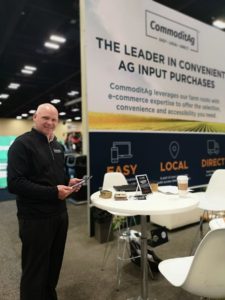Amidst COVID, ‘Amazon Effect’ Boosts Ag E-commerce
Back in late February, we spoke with John Demerly, Chief Executive of CommoditAg at Commodity Classic – one of the last ag events to happen before the lockdown, and before the coronavirus threat amounted to barely a side note to conversations. (As a matter of fact, when we brought up the topic on the trade show floor, some were surprised or even dismissive.) Not two weeks later, the world changed.
Demerly, a veteran of Corteva AgriScience U.S. business, joined the young farm input ecommerce company in 2017 to lead it to full-fledged commercial launch this year following two years of proof-of-concept and beta testing.
Fast-forward to September, the winds have changed in favor of e-commerce amidst COVID. In prior years, the company needed to recruit suppliers to join its marketplace, but now suppliers come knocking on its door, hoping to jump aboard the CommoditAg site in addition to traditional brick-and-mortar and other online distribution channels.
On Tuesday, the company announced it would add Vestaron, the specialty crop bioinsecticide player, to its growing supplier network.
“CommoditAg is committed to sourcing products from a variety of suppliers that growers may not have access to,” like Vestaron’s Spear family of peptide-based insecticides, Demerly said.
“Partnering with CommoditAg will enable growers in the Midwest and Great Lakes to access Spear for their specialty crops and allow for a new sustainable solution that is as effective as traditional synthetic products,” added Ben Cicora, Vestaron Senior Vice President of Sales and Marketing.
Back in February, standard crop protection dominated the CommoditAg offering, but it’s since expanded to seed, agricultural lubricants, micronutrients, biologicals (as seen in the Vestaron deal), animal nutrition, and now data services in a partnership with Main Street Data selling its MarketVision product.
Startup suppliers that have solid products but lack marketing capabilities and channel access are approaching CommoditAg to link up, too, akin to a third-party seller on Amazon.
In the next few months, it is set to add agricultural equipment for the precision ag space; details of that deal are still under wraps.
Likewise, Demerly has witnessed the pandemic bolster e-commerce buy-in from retailers. CommoditAg has added four new retail partners to its network since February, bringing on 10 to 15 new retail warehouse locations acting as its fulfillment centers. The company now has 14 retail partners with over 45 fulfillment centers from Ohio to Colorado and south into Texas. While it delivers anywhere in the U.S., the presence of the fulfillment centers makes for a better customer experience.
“(Ag retailers) are really thinking through what their multichannel approach looks like, and how they embrace e-commerce as part of that,” he said. Instead of viewing it as a threat or choosing a single e-commerce platform for necessity’s sake, retailers are increasingly approaching the channel from a much wider lens: how to segment their customers, how to go to market, how to choose the partners with whom they work.
Its retail partners are also adding to the marketplace by selling their own products and brands to reach a broader set of customers, he noted.
“We’ll see nearly every progressive retailer out there adopt some form of e-commerce, whether it be their own e-storefront or being part of a marketplace like CommoditAg, or better yet both,” Demerly said, adding that not all e-commerce players are the same. AgVend, with its recent shift away from its marketplace to building e-commerce sites for retailers, he sees as “a very complementary strategy” to that of CommoditAg.
The Amazon Effect
No different from countless businesses, the most challenging aspect of the lockdown for the company was not being able to meet face-to-face with suppliers and retailer partners, Demerly told CropLife® in our follow-up chat on Aug. 28.
“A number of great things occurred via Zoom, and there was some efficiency in that,” he acknowledged, “but you can’t replace the ability to sit in a room and do some planning together. That was something we missed and probably something that could have propelled us even faster.”
The pandemic did not dramatically increase the overall e-commerce trend within the farm community, he said, but it did prompt more growers to explore their options. The “Amazon effect” greatly drove up the number of growers purchasing inputs online. “They were trying us out, buying a little at a time. The awareness of e-commerce and consumer online buying habits set the stage for more rapid adoption of e-commerce in the future.”
How COVID has changed agriculture in the long run is not entirely clear yet, Rabobank’s August 2020 North American Agribusiness Review noted.
“However, one space where we have seen a global shift is in the process of buying inputs,” the report said, continuing: “It is estimated that the percentage of inputs that are bought through e-commerce platforms in North America is in the low-single digit percentage range. However, some platforms have quoted growth in year-over-year sales for farm inputs from 100% to 900%. Seasonally, you could put this down to social distancing, but structurally, the increase has been driven by the growth in e-commerce offerings.”
“Our objective is to continue to provide transparent, comprehensive, and convenient offer to farmers. We are focused on building awareness and most importantly, trust: trust in the process, trust in the fact that the farmer can buy something online easily, and trust not only the product they’re receiving but also the delivery and fulfillment,” Demerly said. “Ultimately, we’re not Silicon Valley coming into ag. We’re agricultural experts with lots of history in this industry enabling technology. We think about the customer first and what they need.”







